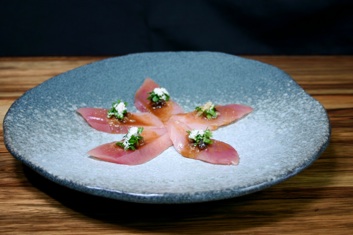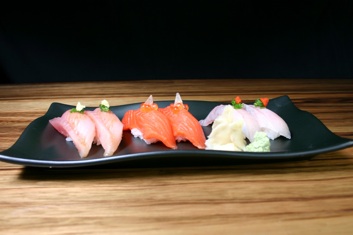Portland, Oregon, OR, Sushi, Japanese, Sustainable, Kristofor Lofgren, Bamboo Sushi, Sunnyside, Marine Stewardship Council, Most Sustainable Restaurant in the United States, Most Sustainable restaurant in the World, Sustainable Fishing, How to eat Sushi, Where to eat sushi in Portland, Best Sushi in Portland, Most Sustainable Sushi, Where is there sustainable sushi, best sustainable restaurants, sustainable seafood guides, what sustainable seafood to eat.
WHAT
Sushi restaurant in Portland, Oregon.
WHY
Certified by the Marine Stewardship Council as the number one sustainable sushi restaurant in the United States and tied for first position in the world.





PORTLAND, OR
RECOMMENDATIONS
Owner Kristofor Lofgren gave us his recommendations on where to eat sushi around the world and restaurants he likes in Portland, OR.


One year ago, two sushi bar owners paid over $100,000 for one 282-pound bluefin tuna at a Japanese auction. The reason the price was so high for the premium fish? Supply and demand.
Over the last 40 years, the bluefin tuna population has declined by more than 80 percent, mostly by Japanese consumers eating sushi and sashimi. The World Wildlife Fund (WWF) has warned that the species could be extinct in three years if drastic measures aren’t taken.
Bamboo Sushi in Portland, Oregon, refuses to serve bluefin tuna. They are a sushi restaurant with a conscious. So much so, that they have been deemed the number one most sustainable sushi bar in the United States by the Marine Stewardship Council and are tied for the prime top spot in the world with Le Manoir aux Quat’ Saisons in England.
Kristofor Lofgren calls himself an “ecopreneur.” He opened Bamboo Sushi in November of 2008 with one goal in mind - to get the MSC’s stamp of approval. This means that all of their fish come from fisheries that have undergone a rigorous assessment for sustainability and environmental responsibility.
“Japanese food is the quintessential harmony and balance cuisine. We don’t need to destroy the environment to enjoy it.”
When and What to Eat

The philosophy of Bamboo Sushi is to think of fish as seasonal, like produce.
There are different times of the year when eating a particular fish is better than others, for instance:
- winter: crab, sea urchin
- late spring/early summer, fall: mackerel
- spring: tuna
- summer: salmon.
They always serve wild-caught and never farmed fish. They also offer flights with 3 and 5 varieties of the same species of fish.
How difficult is it to serve only sustainable fish? “When people taste what these fish should taste like, then they understand. Hamachi is not supposed to taste like goopy cat food that’s creamy butter yellow. It is actually closer to mackerel than tuna, and should be meaty and thick with vibrant pink, white, yellow and gray.”
What are the top three fish you should avoid? “Bluefin tuna, unagi (fresh water eel) and octopus. Instead choose sea eel, big eye or albacore tuna, and spear squid, which is phenomenal. It’s almost like pasta and it’s plentiful. Lots of sushi places buy unagi prepackaged from Korea. They then pop it in the toaster oven and put the sweet sauce on top, which masks the taste.” Fresh water eel is often raised in open net pens which allow waste products, disease and parasites from the farm to flow directly into the surrounding environment – impacting the habitat and the wild eel.
What Role can Consumers Play

What are some things you can do? “Don’t be afraid of frozen fish. In fact, using frozen fish reduces food waste and helps repopulation. Amaebi (spot prawn) from Canada is a great example of tasting better after being frozen. It’s sweeter.”
Avoid red-listed fish like bluefin tuna and farmed salmon. Monterey Bay Aquarium suggests choosing wild-caught Alaska salmon (sake), farmed scallops (hotate) and Pacific halibut (hirame) as more sustainable choices.
Downloadable and Printable Guides

To help you navigate the seafood landscape, the Monterey Bay Aquarium has a free Seafood Watch iPhone App.
Blue Ocean Institute offers a seafood guide.
The sustainable restaurant guide, Fish2Fork, is a good resource and has rated the best and worst most sustainable sushi restaurants in the US. Here are a few of the best and worst:
The Best
1. Bamboo Sushi, Portland, OR
2. Ray's Boathouse, Seattle, WA
3. Blue Ridge, Washington, DC
The Worst
1. Nobu, New York, NY
2. Bar Masa, New York, NY
3. 15 East, New York, NY

BAMBOO SUSHI - SUSTAINABLE SUSHI
March 10, 2010

Japanese / Sustainable Sushi
Sunnyside
310 Southeast 28th Avenue
Portland, OR 97214 (view map)
T: 503.232.5255
Website:
Hours:
Daily: 5 pm - 10 pm



1. Eat your fish from least oil content to most (e.g. mackerel first, salmon belly last). This is so that you don’t coat your palate with oil from the beginning of the meal, thereby limiting your ability to taste very delicate flavors.
2. Don’t cross your chopsticks when you set them down.
3. Use your hands when eating nigiri. It was originally street food and often consumed with the hands. Eating nigiri with the hands is totally acceptable.
4. Eat your nigiri in one bite. You should not take more than one bite, two at most.
5. Rather than soaking your fish in soy sauce, delicately dip your fish. When eating nigiri, you dip fish side down into the soy sauce, not the rice.
6. Do not put an excessive amount of soy sauce in your ramekin. It is thought best to use all of the soy sauce you pour, therefore, only pour as much as you will need. You are always welcome to re-pour more soy sauce.
7. Limit the amount of wasabi you put in your soy sauce. Too much wasabi does not allow for the full flavor of delicate fish to come out. The same is true of the ginger, which is used to cleanse the palate. Do not put it into your soy sauce or eat more than one thin piece in between each bit.


Owner Kristofor Lofgren gave us his recommendations on where to eat sushi around the world and restaurants he likes in Portland, OR.
RECOMMENDATIONS




SUSHI EATING TIPS


















